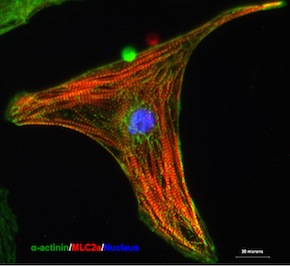New stem cell technique promises abundance of key heart cells
Cardiomyocytes, the workhorse cells that make up the beating heart, can now be made cheaply and abundantly in the laboratory.
Writing this week (May 28, 2012) in the Proceedings of the National Academy of Sciences, a team of Wisconsin scientists describes a way to transform human stem cells — both embryonic and induced pluripotent stem cells — into the critical heart muscle cells by simple manipulation of one key developmental pathway. The technique promises a uniform, inexpensive and far more efficient alternative to the complex bath of serum or growth factors now used to nudge blank slate stem cells to become specialized heart cells.

A single human cardiomyocyte grown using a method devised by UW–Madison chemical and biological engineering graduate student Xiaojun Lian. Cardiomyocytes, the workhorse muscle cells of the heart, can now be grown cheaply and abundantly in the lab, thanks to the new method devised by Lian and his colleagues. Image: Xiaojun Lian
“Our protocol is more efficient and robust,” explains Sean Palecek, the senior author of the new report and a University of Wisconsin–Madison professor of chemical and biological engineering. “We have been able to reliably generate greater than 80 percent cardiomyocytes in the final population while other methods produce about 30 percent cardiomyocytes with high batch-to-batch variability.”
The ability to make the key heart cells in abundance and in a precisely defined way is important because it shows the potential to make the production of large, uniform batches of cardiomyocytes routine, according to Palecek. The cells are in great demand for research, and increasingly for the high throughput screens used by the pharmaceutical industry to test drugs and potential drugs for toxic effects.
Cardiomyocytes, the beating, workhorse cells of the heart, can now be made cheaply and in abundance using a new method devised by researchers in the UW–Madison Department of Chemical and Biological Engineering. These beating cells are in demand for research, to model heart disease and to test drugs and potential drugs for toxic effects. They are also of interest for potential therapies to treat heart disease. Video courtesy of Xiaojun Lian.
The capacity to make the heart cells using induced pluripotent stem cells, which can come from adult patients with diseased hearts, means scientists will be able to more readily model those diseases in the laboratory. Such cells contain the genetic profile of the patient, and so can be used to recreate the disease in the lab dish for study. Cardiomyocytes are difficult or impossible to obtain directly from the hearts of patients and, when obtained, survive only briefly in the lab.
Scientists also have high hopes that one day healthy lab-grown heart cells can be used to replace the cardiomyocytes that die as a result of heart disease, the leading cause of death in the United States.
“Many forms of heart disease are due to the loss or death of functioning cardiomyocytes, so strategies to replace heart cells in the diseased heart continue to be of interest,” notes Timothy Kamp, another senior author of the new PNAS report and a professor of cardiology in the UW School of Medicine and Public Health. “For example, in a large heart attack up to 1 billion cardiomyocytes die. The heart has a limited ability to repair itself, so being able to supply large numbers of potentially patient-matched cardiomyocytes could help.”
“These cells will have many applications,” says Xiaojun Lian, a UW–Madison graduate student and the lead author of the new study. The beating cells made using the technique he devised have, so far, been maintained in culture in the lab for six months and remain as viable and stable as the day they were created.
Lian and his colleagues found that manipulating a major signaling pathway known as Wnt — turning it on and off at prescribed points in time using just two off-the-shelf small molecule chemicals — is enough to efficiently direct stem cell differentiation to cardiomyocytes.
“The fact that turning on and then off one master signaling pathway in the cells can orchestrate the complex developmental dance completely is a remarkable finding as there are many other signaling pathways and molecules involved,” says Kamp.
“The biggest advantage of our method is that it uses small molecule chemicals to regulate biological signals,” says Palecek. “It is completely defined, and therefore more reproducible. And the small molecules are much less expensive than protein growth factors.”
Also contributing to the Wisconsin study, which was supported by the National Institutes of Health and the National Science Foundation, were Cheston Hsiao, Gisela Wilson, Kexian Zhu, Laurie Hazeltine, Samira M. Azarin, Kunil K. Raval and Jianhua Zhang, all of UW–Madison.
